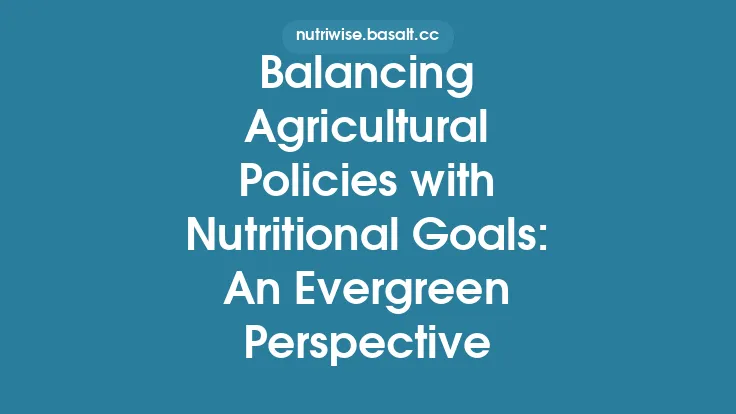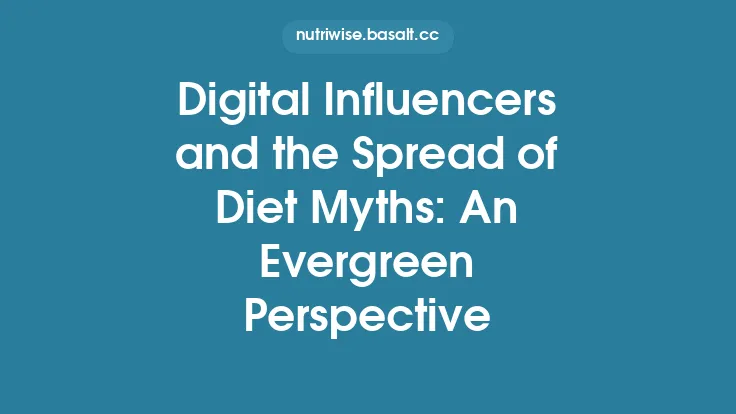Integrating sustainability into clinical nutrition guidelines is no longer a peripheral consideration—it is becoming a core component of responsible health care practice. As clinicians, dietitians, and policy makers strive to improve patient outcomes, they must also recognize that the environmental footprint of dietary recommendations can influence public health on a global scale. This article explores the foundational concepts, methodological approaches, and practical tools that enable the seamless incorporation of sustainability into clinical nutrition guidelines, offering an evergreen framework that remains relevant across evolving scientific landscapes.
Why Sustainability Matters in Clinical Nutrition
- Interconnected Health Outcomes: The health of individuals is tightly linked to the health of ecosystems. Diets high in resource‑intensive foods (e.g., red meat) are associated with higher rates of cardiovascular disease, while also contributing disproportionately to greenhouse gas (GHG) emissions, water scarcity, and land degradation.
- Long‑Term Resource Availability: Sustainable food systems ensure that essential nutrients remain accessible for future generations. Overexploitation of fisheries, soil depletion, and climate‑driven crop failures threaten the stability of nutrient supplies.
- Ethical Responsibility: Health professionals have an ethical duty to consider the broader consequences of their recommendations, aligning clinical practice with the principle of “do no harm” at both the patient and planetary levels.
Core Principles for Sustainable Guideline Development
- Dual‑Outcome Focus
Guidelines should simultaneously address *clinical efficacy (e.g., disease risk reduction, nutrient adequacy) and environmental impact* (e.g., GHG emissions, water use, biodiversity loss). This dual focus ensures that recommendations do not sacrifice one goal for the other.
- Evidence Integration Across Disciplines
- Nutritional Evidence: Systematic reviews, meta‑analyses, and randomized controlled trials remain the gold standard for assessing health outcomes.
- Environmental Evidence: Life‑cycle assessment (LCA) data, carbon footprint databases, and water‑footprint metrics provide quantitative measures of environmental impact.
- Socio‑Economic Context: Cost‑effectiveness analyses and equity assessments help gauge feasibility across diverse populations.
- Flexibility and Contextualization
Sustainable recommendations must be adaptable to regional food systems, cultural preferences, and socioeconomic realities. A “one‑size‑fits‑all” approach risks alienating populations and undermining adherence.
- Transparency and Stakeholder Engagement
Involving clinicians, environmental scientists, patient advocacy groups, and industry representatives throughout the guideline development process promotes trust and ensures that multiple perspectives are considered.
Methodological Framework for Integration
| Step | Description | Key Tools & Resources |
|---|---|---|
| 1. Define Scope & Objectives | Clarify clinical target (e.g., hypertension, diabetes) and sustainability goals (e.g., ≤ 2 kg CO₂e per 100 g of protein). | WHO guideline development handbook; IPCC climate mitigation pathways. |
| 2. Conduct Parallel Evidence Reviews | Perform systematic reviews for health outcomes and environmental impacts of each food group or dietary pattern. | PRISMA guidelines; LCA databases such as ecoinvent, Agri-footprint. |
| 3. Quantify Trade‑offs | Use multi‑criteria decision analysis (MCDA) to weigh health benefits against environmental costs. | Analytic Hierarchy Process (AHP); software like Expert Choice, D-Sight. |
| 4. Draft Recommendations | Formulate statements that meet pre‑defined thresholds for both health efficacy and sustainability. | GRADE (Grading of Recommendations Assessment, Development and Evaluation) adapted for sustainability. |
| 5. Peer Review & Public Consultation | Solicit feedback from interdisciplinary experts and target user groups. | Online platforms (e.g., OpenScience Framework) for transparent comment tracking. |
| 6. Implementation Planning | Develop tools (e.g., decision aids, patient handouts) that translate guidelines into practice. | Mobile apps with carbon‑footprint calculators; EMR integration modules. |
| 7. Monitoring & Updating | Establish indicators for health outcomes and environmental metrics; schedule periodic reviews. | Dashboards linking clinical data (EHR) with sustainability dashboards (e.g., carbon accounting software). |
Practical Strategies for Clinicians
- Prioritize Plant‑Forward Patterns: Encourage diets rich in legumes, whole grains, nuts, seeds, fruits, and vegetables. These foods typically have lower GHG emissions per gram of protein and provide high nutrient density.
- Promote Seasonal and Local Produce: Seasonal foods reduce the need for energy‑intensive storage and transportation, thereby lowering carbon footprints.
- Advise on Portion Size and Food Waste Reduction: Educate patients on appropriate portion sizes and proper food storage to minimize waste, which represents a hidden environmental cost.
- Incorporate Sustainable Protein Alternatives: When appropriate, suggest plant‑based proteins (e.g., soy, pea protein) or emerging low‑impact animal proteins (e.g., insect protein, cultured meat) as part of a balanced diet.
- Use Decision‑Support Tools: Leverage digital platforms that display both nutrient profiles and environmental metrics for food items, enabling patients to make informed choices at the point of selection.
Case Example: Sustainable Dietary Pattern for Type 2 Diabetes Management
| Component | Clinical Rationale | Sustainability Profile |
|---|---|---|
| Whole‑grain cereals | Improves glycemic control, provides fiber. | Low GHG emissions; high land‑use efficiency. |
| Legume‑based meals (e.g., lentil stew) | High protein, low glycemic index. | 70 % lower CO₂e than equivalent animal protein. |
| Non‑starchy vegetables | Micronutrient dense, low calorie. | Minimal water footprint when grown locally. |
| Nuts & seeds (moderate portion) | Improves lipid profile. | Higher per‑kilogram emissions than legumes but offset by lower overall consumption. |
| Limited fish (e.g., sustainably certified) | Provides omega‑3 fatty acids. | Variable impact; choose MSC‑certified sources to ensure lower overfishing risk. |
| Reduced red meat (≤ 2 servings/week) | Lowers cardiovascular risk. | Significant reduction in GHG emissions compared to higher intake. |
This pattern meets evidence‑based glycemic targets while achieving a ~30 % reduction in carbon footprint relative to a conventional Western diet.
Tools and Resources for Ongoing Application
- Carbon Footprint Databases: USDA FoodData Central now includes environmental impact metrics; the European Commission’s “Food Sustainability Index” offers comparable data for EU foods.
- Nutrition‑Sustainability Scoring Systems: The “Sustainable Diet Index” (SDI) combines nutrient adequacy scores with environmental indicators, providing a single composite metric for guideline developers.
- Clinical Decision Support (CDS) Modules: Integration of sustainability alerts into electronic health records (EHR) can prompt clinicians when a prescribed diet exceeds predefined environmental thresholds.
- Patient‑Facing Apps: Platforms such as “FoodPrint” or “EcoDiet” allow users to log meals and receive real‑time feedback on both nutritional quality and environmental impact.
Challenges and Mitigation Strategies
| Challenge | Potential Impact | Mitigation Approach |
|---|---|---|
| Data Gaps in LCA for Certain Foods | Incomplete sustainability assessments may bias recommendations. | Use proxy data from similar food categories; update guidelines as new LCA data become available. |
| Cultural Acceptability | Recommendations that conflict with traditional diets may reduce adherence. | Conduct culturally tailored focus groups; incorporate traditional sustainable foods (e.g., millet, sorghum) where appropriate. |
| Economic Constraints | Sustainable foods can be perceived as more expensive. | Highlight cost‑effective plant proteins; partner with community programs that improve access to affordable produce. |
| Clinical Workflow Integration | Additional sustainability considerations may increase consultation time. | Deploy pre‑visit questionnaires that capture patient preferences; use automated CDS alerts to streamline decision‑making. |
Monitoring Success: Indicators and Benchmarks
- Health Indicators: Changes in disease biomarkers (HbA1c, LDL‑C), patient-reported outcomes, and adherence rates.
- Environmental Indicators: Average dietary carbon intensity (kg CO₂e per day), water use per diet, and waste reduction percentages.
- Equity Indicators: Access to sustainable food options across socioeconomic strata; disparity analyses to ensure recommendations do not exacerbate health inequities.
Regular reporting of these metrics, ideally through a unified dashboard accessible to clinicians, researchers, and policy makers, creates a feedback loop that sustains the relevance and impact of the guidelines.
Concluding Thoughts
Embedding sustainability into clinical nutrition guidelines transforms the practice of dietetics from a solely patient‑centric discipline into a catalyst for planetary health. By adhering to the evergreen principles outlined—dual‑outcome focus, interdisciplinary evidence integration, contextual flexibility, and transparent stakeholder engagement—guideline developers can craft recommendations that stand the test of time, scientific advancement, and shifting environmental realities. The ultimate goal is a health care system where every dietary prescription not only improves individual well‑being but also contributes to a resilient, low‑impact food system for generations to come.





